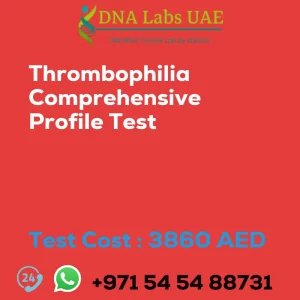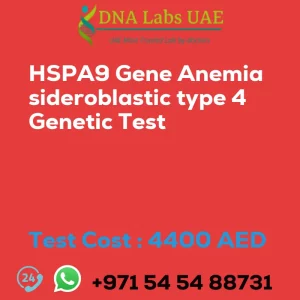ADAMTS13 ACTIVITY Test – Genetic Lab, DNA Labs UAE
Test Name: ADAMTS13 ACTIVITY Test
Components: Price: 4800.0 AED
Sample Condition: 3 mL whole blood in 1 Blue Top (Sodium Citrate) tube. Mix thoroughly by inversion. Transport to Lab within 4 hours. If this is not possible, make PPP within 1 hour of collection as follows: Centrifuge sample at 3600 rpm for 15 min. & transfer supernatant to a clean plastic tube. Centrifuge this supernatant again at 3600 rpm for 15 mins. & finally transfer the supernatant (PPP) to 1 labelled, clean plastic screw capped vial. FREEZE IMMEDIATELY. Ship frozen. DO NOT THAW. Overnight fasting is preferred. Duly filled Coagulation Requisition Form (Form 15) is mandatory.
Report Delivery: 4 weeks
Method: Chemiluminscent Immunoassay
Test type: Disorders of Coagulation
Doctor: Hematologist
Test Department: COAGULATION
Pre Test Information: Overnight fasting is preferred. Duly filled Coagulation Requisition Form (Form 15) is mandatory.
Test Details:
The ADAMTS13 activity test is a laboratory test that measures the activity level of ADAMTS13, which is an enzyme involved in the breakdown of von Willebrand factor (vWF). ADAMTS13 is responsible for cutting vWF into smaller fragments, preventing the formation of blood clots. This test is primarily used to diagnose and monitor a rare blood disorder called thrombotic thrombocytopenic purpura (TTP).
In TTP, there is a deficiency or dysfunction of ADAMTS13, leading to the accumulation of large vWF multimers and the formation of blood clots in small blood vessels throughout the body. The ADAMTS13 activity test involves taking a blood sample from the patient and measuring the ability of the patient’s plasma to cleave a synthetic peptide. The activity level is expressed as a percentage, with normal levels typically ranging from 50% to 150%.
A low ADAMTS13 activity level suggests a deficiency or dysfunction of the enzyme, which is consistent with a diagnosis of TTP. However, it is important to note that other conditions, such as liver disease or certain medications, can also cause a decrease in ADAMTS13 activity.
In addition to the ADAMTS13 activity test, other tests, such as vWF antigen and vWF multimer analysis, may be performed to further evaluate the patient’s condition and determine the underlying cause of the ADAMTS13 deficiency.
Overall, the ADAMTS13 activity test is a valuable tool in the diagnosis and management of TTP, helping healthcare providers assess the patient’s risk of developing blood clots and guide appropriate treatment strategies.
| Test Name | ADAMTS13 ACTIVITY Test |
|---|---|
| Components | |
| Price | 4800.0 AED |
| Sample Condition | 3 mL whole blood in 1 Blue Top (Sodium Citrate) tube. Mix thoroughly by inversion. Transport to Lab within 4 hours. If this is not possible, make PPP within 1 hour of collection as follows: Centrifuge sample at 3600 rpm for 15 min. & transfer supernatant to a clean plastic tube. Centrifuge this supernatant again at 3600 rpm for 15 mins. & finally transfer the supernatant (PPP) to 1 labelled, clean plastic screw capped vial. FREEZE IMMEDIATELY. Ship frozen. DO NOT THAW. Overnight fasting is preferred. Duly filled Coagulation Requisition Form (Form 15) is mandatory. |
| Report Delivery | 4 weeks |
| Method | Chemiluminscent Immunoassay |
| Test type | Disorders of Coagulation |
| Doctor | Hematologist |
| Test Department: | COAGULATION |
| Pre Test Information | Overnight fasting is preferred. Duly filled Coagulation Requisition Form (Form 15) is mandatory. |
| Test Details |
The ADAMTS13 activity test is a laboratory test that measures the activity level of ADAMTS13, which is an enzyme involved in the breakdown of von Willebrand factor (vWF). ADAMTS13 is responsible for cutting vWF into smaller fragments, preventing the formation of blood clots. This test is primarily used to diagnose and monitor a rare blood disorder called thrombotic thrombocytopenic purpura (TTP). In TTP, there is a deficiency or dysfunction of ADAMTS13, leading to the accumulation of large vWF multimers and the formation of blood clots in small blood vessels throughout the body. The ADAMTS13 activity test involves taking a blood sample from the patient and measuring the ability of the patient’s plasma to cleave a synthetic peptide. The activity level is expressed as a percentage, with normal levels typically ranging from 50% to 150%. A low ADAMTS13 activity level suggests a deficiency or dysfunction of the enzyme, which is consistent with a diagnosis of TTP. However, it is important to note that other conditions, such as liver disease or certain medications, can also cause a decrease in ADAMTS13 activity. In addition to the ADAMTS13 activity test, other tests, such as vWF antigen and vWF multimer analysis, may be performed to further evaluate the patient’s condition and determine the underlying cause of the ADAMTS13 deficiency. Overall, the ADAMTS13 activity test is a valuable tool in the diagnosis and management of TTP, helping healthcare providers assess the patient’s risk of developing blood clots and guide appropriate treatment strategies. |








